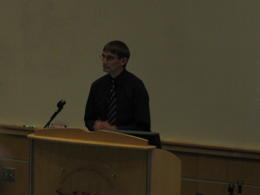May 27 - August 1

Are Freezing Rain Patterns in the South Central United States Changing?
Timothy Bonin and Deke Arndt
Abstract:
Daily surface climatological reports in conjunction with radiosonde data was analyzed from a period of 1950-2007 for five stations in the South Central United States. From this data, the annual number of possible snow, rain, and icy precipitation events was determined by analyzing characteristics of the troposphere for two mandatory radiosonde launches for each wintertime precipitation day. The number of “potentially significant freezing rain events” was also determined for each location. It was determined that there is an “ice belt” in which icy precipitation, which includes sleet, graupel, and freezing rain, is more likely to fall. This ice belt has moved northwest with time. The occurrence of potentially significant freezing rain events is not associated with this ice belt. Instead, the frequency of these events has its own trend and has been generally increasing, principally from the 1980s onward. However, there was a drastic decline in the number of these events in the early 2000s. This result is counterintuitive due to the fact that there have been several very damaging ice storms in the early and mid 2000s. The correlation between icy precipitation events/freezing rain and various teleconnections is also evaluated in this study.